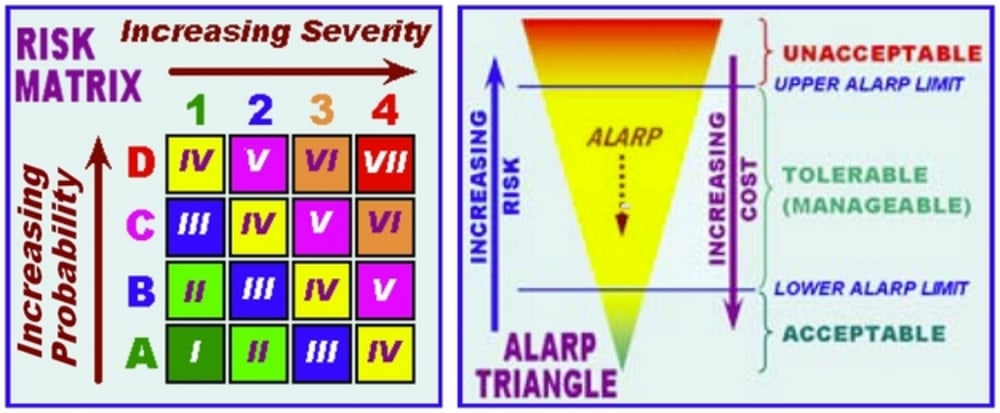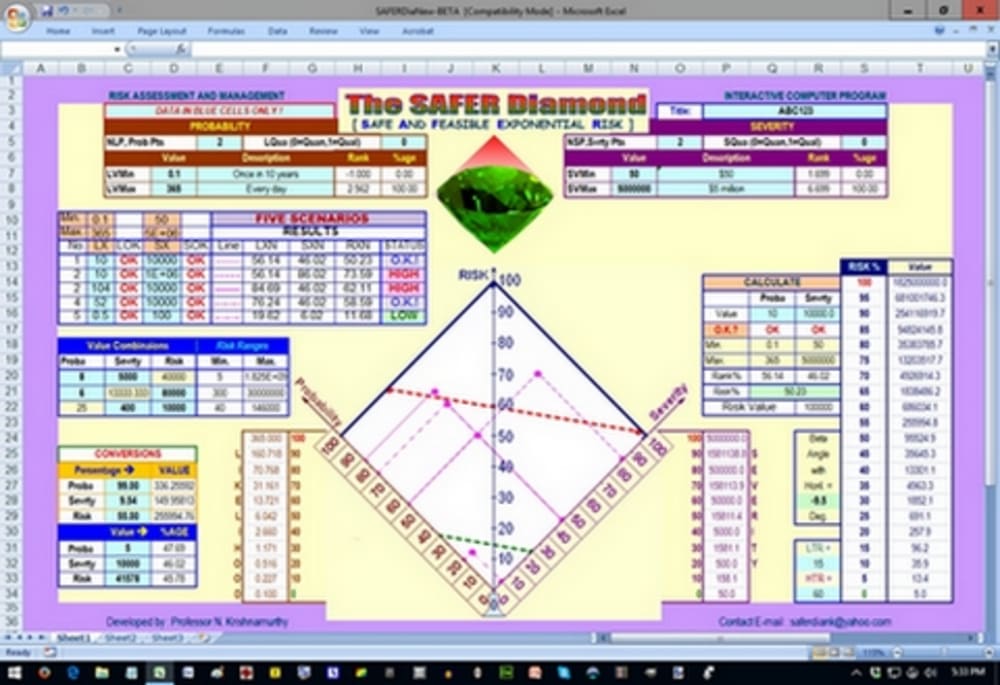SAFER (“Safe And Feasible Exponential Risk”) Diamond® is a novel risk assessment and management tool, with a user-friendly graphical presentation format of data and results.
While incorporating the best features of the familiar Risk Matrix to obtain quantitative risk (R) as product of probability (P) and severity (S) of loss, and ALARP (“As Low As Reasonably Practicable”) triangle as depicted in Fig. 1, it offers many advantages over existing methods.
The technique differs from existing job hazard analysis methods as follows:
(1) It requires input of only minimum and maximum values of probability P of occurrence and severity S of consequence of any loss, instead of sets of three or more arbitrary values in sequence.
(2) It provides a continuous precise functional analysis of data rather than broad qualitative estimates or a step-wise quantitative analysis.
(3) It maps the resulting risk domain continuously and uniquely, rather than lump all risks into a few arbitrary categories.
(4) It integrates the wide variability of risk factors and normalises the entire range of data and results into a standard span of 0-100%, so that comparative evaluations across various projects and different industries become feasible.
The diamond-shaped graphical representation of data and results also yields benefits, first with the hyperbolic risk contours (P*S) being transformed to straight lines (logP+logS) in the log-log domain, second displaying the vast ranges of data and results compressed into a standardized format of familiar percentages, as shown in screen-shot of Fig. 2.
Apart from the automatic scaling and normalization in a continuous domain, the main strengths of the computerized theoretical and graphical technique are that it is (i) on-line, (ii) real-time, (iii) instantaneous and (iv) interactive – all of which qualities are essential for today's fast-changing real world of finance, air-traffic control etc.
Dialogue boxes allow forward and backward computations between values and percentages of probability, severity, and risk. Any risk status may be located in the chart. These features facilitate critical scenario-building and decision-making on the fly.
With SAFER Diamond technique, different scenarios may be investigated and mapped:
(a) What is the expected risk loss for a certain combination of probability and severity?
(b) If the project can afford only x dollars for risk protection, what risk percentage must be set as “Unacceptable Risk Limit”?
(c) If risk loss below y dollars is insignificant in the overall budget, what risk percentage may be set as the “Acceptable Risk Limit”?
(d) To achieve a desired risk protection, what investment (or insurance coverage) should be planned for? What different P and S combinations are available to control risk within this limit?
(e) To reduce the risk of a certain loss scenario to a desired level, if probability can be reduced by p units, then, by how many units s of severity should the loss be reduced (or, perhaps, even be allowed to increase)? And vice versa?
SAFER Diamond has been patented in Singapore and Australia.
It can be a powerful tool for critical decisions involving risk.
Like this entry?
-
About the Entrant
- Name:Natarajan Krishnamurthy
- Type of entry:individual
- Software used for this entry:MS-EXCEL
- Patent status:patented





